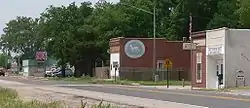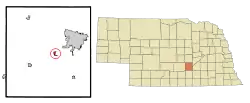Alda, Nebraska
Alda is a village in Hall County, Nebraska, United States. The population was 642 at the 2010 census. It is part of the Grand Island, Nebraska Micropolitan Statistical Area.
Alda, Nebraska | |
|---|---|
 Downtown Alda: north side of U.S. Highway 30, looking northwest | |
| Motto(s): "Working Together For A Brighter Future" | |
 Location of Alda, Nebraska | |
| Coordinates: 40°52′8″N 98°28′7″W | |
| Country | United States |
| State | Nebraska |
| County | Hall |
| Area | |
| • Total | 0.56 sq mi (1.46 km2) |
| • Land | 0.56 sq mi (1.46 km2) |
| • Water | 0.00 sq mi (0.00 km2) |
| Elevation | 1,916 ft (584 m) |
| Population | |
| • Total | 642 |
| • Estimate (2019)[3] | 662 |
| • Density | 1,171.68/sq mi (452.17/km2) |
| Time zone | UTC-6 (Central (CST)) |
| • Summer (DST) | UTC-5 (CDT) |
| ZIP code | 68810 |
| Area code(s) | 308 |
| FIPS code | 31-00625[4] |
| GNIS feature ID | 0826936[5] |
History
The Alda area was first settled in 1859.[6] The village has the name of the first white child born within its borders.[7] The town of Alda moved to its current site in 1873 in order to be on the railroad.[8]
Geography
Alda is located at 40°52′8″N 98°28′7″W (40.868932, -98.468529).[9]
According to the United States Census Bureau, the village has a total area of 0.35 square miles (0.91 km2), all land.[10]
Demographics
| Historical population | |||
|---|---|---|---|
| Census | Pop. | %± | |
| 1930 | 153 | — | |
| 1940 | 151 | −1.3% | |
| 1950 | 190 | 25.8% | |
| 1960 | 229 | 20.5% | |
| 1970 | 456 | 99.1% | |
| 1980 | 601 | 31.8% | |
| 1990 | 540 | −10.1% | |
| 2000 | 652 | 20.7% | |
| 2010 | 642 | −1.5% | |
| 2019 (est.) | 662 | [3] | 3.1% |
| U.S. Decennial Census[11] | |||
2010 census
As of the census[2] of 2010, there were 642 people, 229 households, and 170 families residing in the village. The population density was 1,834.3 inhabitants per square mile (708.2/km2). There were 253 housing units at an average density of 722.9 per square mile (279.1/km2). The racial makeup of the village was 85.2% White, 0.9% African American, 13.7% from other races, and 0.2% from two or more races. Hispanic or Latino of any race were 16.0% of the population.
There were 229 households, of which 37.6% had children under the age of 18 living with them, 57.2% were married couples living together, 10.0% had a female householder with no husband present, 7.0% had a male householder with no wife present, and 25.8% were non-families. 19.7% of all households were made up of individuals, and 4.8% had someone living alone who was 65 years of age or older. The average household size was 2.80 and the average family size was 3.24.
The median age in the village was 33.5 years. 30.4% of residents were under the age of 18; 7.5% were between the ages of 18 and 24; 24% were from 25 to 44; 27.6% were from 45 to 64; and 10.4% were 65 years of age or older. The gender makeup of the village was 50.5% male and 49.5% female.
2000 census
As of the census[4] of 2000, there were 652 people, 237 households, and 172 families residing in the village. The population density was 1,859.3 people per square mile (719.3/km2). There were 248 housing units at an average density of 707.2 per square mile (273.6/km2). The racial makeup of the village was 95.55% White, 0.31% African American, 0.31% Native American, 0.15% Asian, 2.91% from other races, and 0.77% from two or more races. Hispanic or Latino of any race were 7.06% of the population.
There were 237 households, out of which 42.6% had children under the age of 18 living with them, 54.0% were married couples living together, 13.1% had a female householder with no husband present, and 27.4% were non-families. 21.5% of all households were made up of individuals, and 3.8% had someone living alone who was 65 years of age or older. The average household size was 2.75 and the average family size was 3.20.
In the village, the population was spread out, with 31.7% under the age of 18, 10.4% from 18 to 24, 31.6% from 25 to 44, 19.6% from 45 to 64, and 6.6% who were 65 years of age or older. The median age was 33 years. For every 100 females, there were 105.7 males. For every 100 females age 18 and over, there were 99.6 males.
As of 2000 the median income for a household in the village was $34,583, and the median income for a family was $39,219. Males had a median income of $24,375 versus $19,722 for females. The per capita income for the village was $18,259. About 7.6% of families and 8.6% of the population were below the poverty line, including 11.5% of those under age 18 and 1.9% of those age 65 or over.
References
- "2019 U.S. Gazetteer Files". United States Census Bureau. Retrieved July 26, 2020.
- "U.S. Census website". United States Census Bureau. Retrieved 2012-06-24.
- "Population and Housing Unit Estimates". United States Census Bureau. May 24, 2020. Retrieved May 27, 2020.
- "U.S. Census website". United States Census Bureau. Retrieved 2008-01-31.
- "US Board on Geographic Names". United States Geological Survey. 2007-10-25. Retrieved 2008-01-31.
- Fitzpatrick, Lillian L. (1960). Nebraska Place-Names. University of Nebraska Press. p. 70. ISBN 0-8032-5060-6. A 1925 edition is available for download at University of Nebraska—Lincoln Digital Commons.
- Federal Writers' Project (1938). Origin of Nebraska place names. Lincoln, NE: Works Progress Administration. p. 5.
- "Alda, Hall County". Center for Advanced Land Management Information Technologies. University of Nebraska. Retrieved 10 August 2014.
- "US Gazetteer files: 2010, 2000, and 1990". United States Census Bureau. 2011-02-12. Retrieved 2011-04-23.
- "US Gazetteer files 2010". United States Census Bureau. Archived from the original on 2012-01-25. Retrieved 2012-06-24.
- "Census of Population and Housing". Census.gov. Retrieved June 4, 2015.
